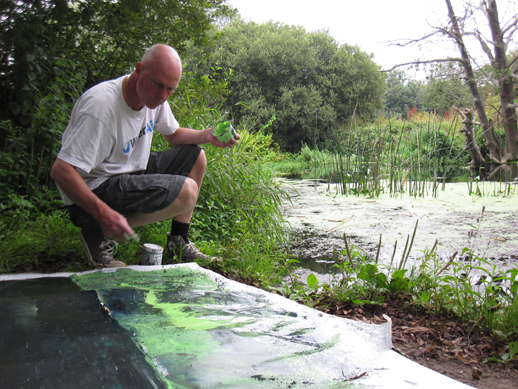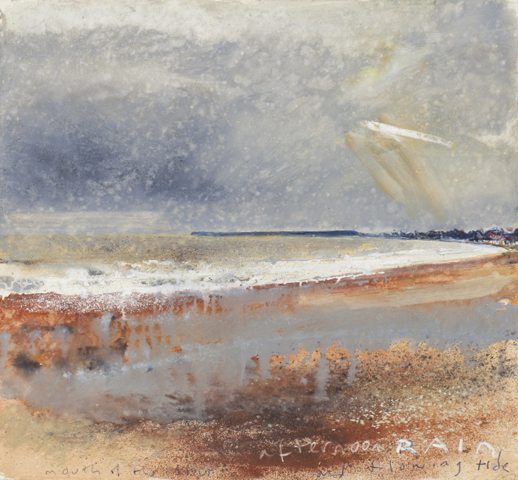 pic: Caroline Jackson
pic: Caroline Jackson
The introduction to the catalogue for Kurt Jackson’s exhibition of recent works, currently on show at The Redfern Gallery, London.
By Robert Macfarlane
‘As I watch the world’, wrote Nan Shepherd in 1945, ‘it arches its back, and each layer of the landscape bristles’. It’s a typically brilliant observation about observation from one of the last century’s least-known great writers. For Shepherd, ‘landscape’ is not something to be viewed and appraised from a distance, as if it were a panel in a frieze or a canvas in a frame. It isn’t the passive object of our gaze, but rather a volatile participant – a fellow subject which arches and bristles at us, bristles into us. Too often, ‘landscape’ is still understood as a noun connoting fixity, scenery, an immobile painterly decorum. I prefer to think of it as a noun that contains a hidden verb: landscape scapes, it is dynamic and commotion-causing, it sculpts and shapes us not only over the courses of our lives but also instant by instant, incident by incident. I prefer to take ‘landscape’ as a collective term for the temperature and pressure of the air, the fall of light and its rebounds, the textures and surfaces of rock and soil, the sounds (birdsong, wave-crash, road-roar), the scents (kelp-stench, car-diesel, the coconut of gorse) and the uncountable other transitory phenomena and atmospheres that together comprise the bristling presence of a particular place at a particular moment.
The bristling of landscape is Kurt Jackson’s subject as an artist, and his brilliance as an artist lies in the success with which he represents his subject in what is, at last, a static medium. Look for instance, at the painting entitled…No, hold on, that won’t do – let me try again. Don’t look at, but watch for a few minutes his painting entitled ‘St Agnes’. The foreground is a furnace, blazing with a gorse-gold that scorches the eye and whose heat is felt in the heart. Beyond that, or rather simultaneous with it, is the incandescence of the sea’s own metal, and within that is the hard black whale-back of St Agnes itself, resilient in the fire, and through it all float the sounds that are faintly jotted in the sky (‘Wind Blow Cow Moo Gull Cry’), and about its edges play other aspects of the moment of record – a sense of peninsularity, of the land both sloping away and fading out at its edges.
 Afternoon rain and flowing tide. Mouth of the Stour, October 2010, mixed media on paper, 57 x 62cm
Afternoon rain and flowing tide. Mouth of the Stour, October 2010, mixed media on paper, 57 x 62cm
All of this goes on – or rather is going on, for the image itself continues to be an event – and acts upon its watcher: an action-painting response to the action-world. If there is a story to the painting it is that of ignition bringing about combustion: the burn of the gorse causing the sear of sea and thus the whole painting acting as a vast fiat lux – but, again, story is the wrong word, for story functions sequentially, in an orderly fashion, and this painting does not tell, it blazes. Elsewhere, the landscape literally participates in the work. Look at (watch) those star-splodges in the sky of ‘Afternoon Rain’, and you quickly realize that they are the afternoon rain, that Jackson has let the raindrops crack upon the canvas, and that it’s rain that’s making the running, co-authoring the image.
The paintings exhibited here constitute an autobiography of a kind, except that they tell not Jackson’s life-history, but his life-geography. Five of the most important locations in his life are represented, each of which has come to possess some kind of territorial imperative for him. The first is the River Stour in Dorset, which winds through Blandford, the town on Jackson’s birth certificate. ‘This is the Stour,’ reads a precise and revisionary jotting in the corner of one painting, ‘this is where I was born.’ The painting is superb: slow waters running deep, the idle glide of the surface, ducks reversing the flow and leaving white wakes behind them, a scatter of birdsong from the bankside trees.
Then there is Ithaca, mythical Ithaca, as realized in the Mani region of Greece to which Jackson first travelled aged twelve, driven there in an old land-rover by his father who had – like so many thousands of others before and since him, including me – fallen under the spell of the prose of Patrick Leigh Fermor, who lived in Kardamyli and wrote so bewitchingly about Greece in general, and the Mani in particular (and indeed anything else he chose to contemplate). Four years after his first visit, Jackson hitch-hiked back on his own and wild-camped for the summer on the beach. More recently he returned again with his own children, and then again with his wife to make paintings like ‘Olive grove full of asphodels and bird song’, in which the asphodels stand – or ‘strike’, perhaps, because nothing ‘stands’ still in a Jackson painting – in the foreground, and the spray-cloud above the trees is at once the leaves of the olives and also the stippled noise of the birdsong.
The third place – type of place, really – is the deep and fast-running rivers of France, to which Jackson was first taken by his parents as a child. Camping on the banks of those rivers, he received his first schooling as a natural historian and zoologist, with the landscape itself as his teacher. The French rivers – in these paintings as in life – are vigorous, charmed and charged: the energetic cousins of the slow, steady Stour.
The fourth and fifth locations in Jackson’s life-geography are in the far south-west, the region with which he is most associated. There is Priest Cove, tucked into the side of Cape Cornwall (Pen Kernow), where Jackson has for years worked in a hut-turned-studio given to him by local fishermen. And there is St Agnes, one of the Scillies: a transitional place, combining as it does the Mediterranean magic of Ithaca and the Atlantic asperities of Cornwall. St Agnes, like Priest Cove, is often bathed by that bright Atlantic coastal light which – due to the absence of particulate matter in the air – falls with a lucidity that can feel, when one is within it, close to a moral quality. Looking at the St Agnes images, though, I am reminded of the island-visions and mirages that have haunted the Atlantic coasts of Britain and Ireland since at least the sixth century: dream-lands (The Islands of the Blest, The Fortunate Isles, Hy-Brasil) shimmered into being by sea-haze, sun-glare and longing.
A life in five places then: the birth-place, the magic isle, the river, the work-place and the promised land. But these locations, in Jackson’s paintings, are not forced into subservience to their artist and his biography. These are not the places that he has come to know; rather, they are the places that have come to know him. Again – as so often – Nan Shepherd has it right: ‘Details are no longer part of a grouping in a picture of which I am the focal point, the focal point is everywhere. Nothing has reference to me, the looker. This is how the Earth must see itself.’ That seems apt for Kurt Jackson, whose paintings, it sometimes seems to me, are as close as we can come to ‘how the Earth must see itself.’
Recent Work is on show at the Redfern Gallery, Cork Street, London until January 26th. Click HERE for further information.